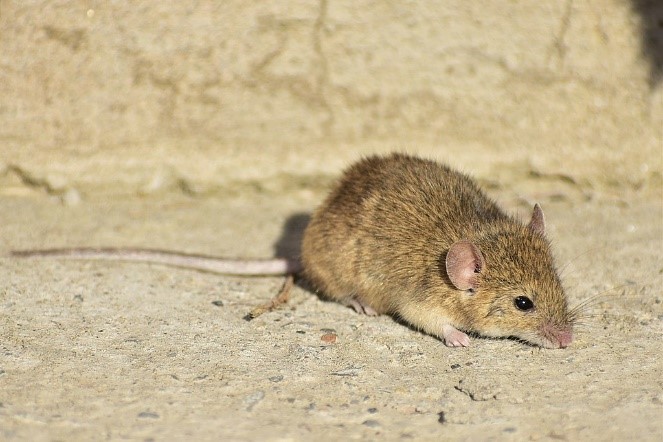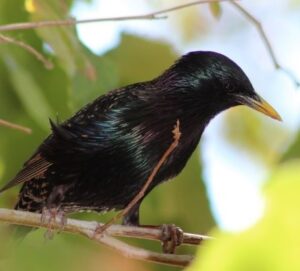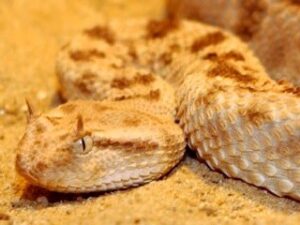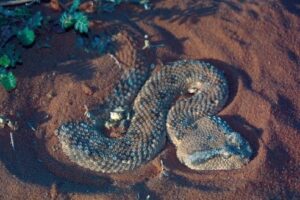
Rodents are considered the most dangerous warm-blooded mammals because they transfer diseases that affect the distribution of human communities. There are about 1,500 living rodent species (out of about 4,000 living mammals overall). More than 35 dangerous diseases are transferred to humans by rodents, either directly through food poisoning through the body, urine, and feces of rodents or indirectly through parasites of rodents. economic losses that are destructive to the environment that humans live within. The damage caused is related to their feeding behavior of gnawing and digging, in which they cause damage to buildings, commercial structures, electric wires, and food products.
To limit the spread of rodents and to avoid the economic and health damages they cause, ETS developed an integrated management strategy to prevent their high reproductive rate and reduce the damage they cause. Rodents are intelligent pests; they are adapted to the environment in which they live, in addition to their ability to maneuver in an orderly fashion. Therefore, there should be a radical change in the environment to deprive the rodents of the necessities of life, both within a limited area (home and farm) and a wide area (village or city).
The family Muridae is considered the common family in the order Rodentia, to which both rats and mice belong. Rodents are divided, based on their relations to humans, into associated rodents (their original home is where the human lives, for example: the house mouse) and not-associated rodents (rodents live inside the human house and get out to search for food or live in burrows outside the house but enter the house for food).
The most common rodents are:
- House Mouse (Gray, Multi-Colored) – Mus musculus Linnaeus (also Mus domesticus)
- Norway Rat (Sewer, Street, House, Common, Hanover, Wharf, Brown) Rattus norvegicus (Berkenhout)
- Climbing Rat (Roof, Ship, Water, Gray- or White-bellied, Black) – Rattus Rattus (Linnaeus)
1-House Mouse:
General Description

- Distribution: Worldwide distribution.
- General Appearance: Small, slender
- Adult size: small
- Body weight: 12-30 g
- Length (nose to the tip of tail) – 6-9 cm
- Length of Tail: 7-10 cm
- Snout: Pointed
- Ears: large, some hair
- Eyes: small
- Tail: uniformly dark
- Fur: light brown, light gray, smooth
- Droppings: rod-shaped, 3-6 mm
Life Cycle and Common Characteristics
- It is characterized by rapidly multiplying, with an annual reproduction rate of about 44 per female rat.
- The maturity period of the female sperm is about 42 days, and the gestation period is 19–21 days.
- The female lays eggs between 4 and 8 times during her life, depending on the nature of the food.
- Up to 5-6 children per pregnancy (and up to 12-20 children in rare cases).
Comparisons of the reproduction characteristics among the three commensal rodents.
| House Mouse | Roof Rat | Norway Rat | Characteristic |
| 42 Day | 68 Day | 75 Day | Days to Maturity |
| 19-21 Day | 20-22 Day | 22-24 Day | Gestation Period |
| 5.8 | 6.2 | 8.8 | Young per Litter |
| 7.67 | 5.42 | 4.32 | Litters per year |
| 44.6 | 33.6 | 38.00 | Young / female / year |
| 1>5-2 Month | 2-3 month | 2-3 month | Age at Mating |
| Year-Long | Spring & Fall | Spring & Fall | Breeding Season |
Comparisons of the characteristic of growth and development of commensal rodents.
| House Mouse | Roof Rat | Norway Rat | Charcater |
| 19-21 day | 20-22 day | 22-24 day | Gestation Period |
| 0.8-1.5 g | 4-5 g | 5-6.5 g | Weight at Birth |
| Without pink hair | Without pink hair | Without pink hair | Hair Color at Birth |
| 3-4 day | 6 day | 3-4 day | Opening the Ear |
| 11-14 day | 14-15 day | 16 day | Opening of the Eye |
| 9-10 day | 10 day | 10 day | Appearance of Lower Incisors |
| 7-8 يوم
7-8 day |
11 day | 11 day | Appearance of Upper Incisors |
| 42 day | 68 day | 75 day | Day to Maturity of Females |
| 1 Year | 1 Year | 1 Year | Length of Life |
- Norway Rat:
General Description

- Distribution: Asian in origin and worldwide in distribution, and quickly adapt to the environment.
- General Appearance: Large, robust
- Adult size: Large
- Body weight: 200-500g,
- Length (nose to the tip of tail): 18-27 cm
- Length of Tail: 13-21 cm
- Snout: blunt
- Ears: small, covered with short hairs; do not reach eyes
- Eyes: Small
- Tail: dark above, pale beneath
- Fur: brown with scattered black; venter gray to yellow-white; shaggy
- Droppings: capsule-shaped, 2cm
The difference between the climbing or roof rat, Rattus rattus and the Norway or brown rat, Rattus norvegicus.
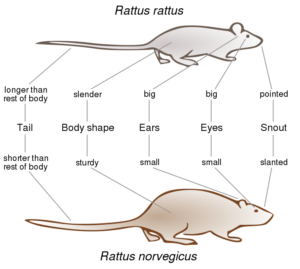
Life Cycle and Common Characteristics
- Norway rats prefer moist environments (cellars, streams, stores, warehouses, and mills).
- considered an excellent swimmer.
- The life cycle of rodents is no more than 1–1.5 years in natural conditions, and females live longer than males.
- Norway rats prefer to live in groups of small families or large groups.
- Breed throughout the year, beginning a period of sexual activity after 3-5 months of birth, a pregnancy lasting 21–25 days, an average female pregnancy of 8–12 short weeks, and a medium repeat pregnancy of 5–10 times a year.
- The life cycle has significantly affected the availability of food.
Comparisons of the reproduction characteristics among the three commensal rodents.
| House Mouse | Roof Rat | Norway Rat | Characteristic |
| 42 Day | 68 Day | 75 Day | Days to Maturity |
| 19-21 Day | 20-22 Day | 22-24 Day | Gestation Period |
| 5.8 | 6.2 | 8.8 | Young per Litter |
| 7.67 | 5.42 | 4.32 | Litters per year |
| 44.6 | 33.6 | 38.00 | Young / fenale/year |
| 1>5-2 Month | 2-3 month | 2-3 month | Age at Mating |
| Year-Long | Spring & Fall | Spring & Fall | Breeding Season |
Comparisons of the characteristic of growth and development of commensal rodents.
| House Mouse | Roof Rat | Norway Rat | Charcater |
| 19-21 day | 20-22 day | 22-24 day | Gestation Period |
| 0.8-1.5 g | 4-5 g | 5-6.5 g | Weight at Birth |
| Without pink hair | Without pink hair | Without pink hair | Hair Color at Birth |
| 3-4 day | 6 day | 3-4 day | Opening the Ear |
| 11-14 day | 14-15 day | 16 day | Opening of the Eye |
| 9-10 day | 10 day | 10 day | Appearance of Lower Incisors |
| 7-8 يوم
7-8 day |
11 day | 11 day | Appearance of Upper Incisors |
| 42 day | 68 day | 75 day | Day to Maturity of Females |
| 1 Year | 1 Year | 1 Year | Length of Life |
- Climbing Rat:
General Description
- Distribution: offshore Far East in origin. Worldwide in distribution.
- General Appearance: sleek, graceful.
- Adult size: medium
- Body weight: 150-250 g

- Body weight: 150-250 g
- Length (nose to the tip of tail): 16-20 cm
- Length of Tail: 19-25 cm
- Snout: pointed
- Ears: large, nearly naked; can be pulled over eyes
- Eyes: large, prominent
- Tail: uniformly dark. The tail is longer than the length of the body and the head together
- Fur: agouti to gray to black; venter white, gray, or black; smooth
- Droppings: spindle- shaped, 0.5 in
The difference between the climbing or roof rat, Rattus rattus and the Norway or brown rat, Rattus norvegicus.
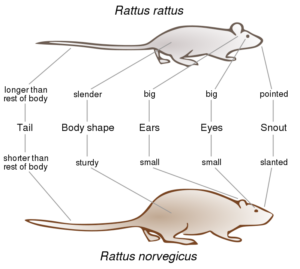
Life Cycle and Common Characteristics
- Breed year-round, beginning a period of sexual activity after 3-5 months of
- Take the climber/roof rat with several wives, which is a large degree of
- The average pregnancy lasts 20-25 days, there are 12 young women per pregnancy, and they have 6-8 pregnancies during their lifetime.
Comparisons of the reproduction characteristics among the three commensal rodents.
| House Mouse | Roof Rat | Norway Rat | Characteristic |
| 42 Day | 68 Day | 75 Day | Days to Maturity |
| 19-21 Day | 20-22 Day | 22-24 Day | Gestation Period |
| 5.8 | 6.2 | 8.8 | Young per Litter |
| 7.67 | 5.42 | 4.32 | Litters per year |
| 44.6 | 33.6 | 38.00 | Young / fenale/year |
| 1>5-2 Month | 2-3 month | 2-3 month | Age at Mating |
| Year-Long | Spring & Fall | Spring & Fall | Breeding Season |
Comparisons of the characteristic of growth and development of commensal rodents.
| House Mouse | Roof Rat | Norway Rat | Charcater |
| 19-21 day | 20-22 day | 22-24 day | Gestation Period |
| 0.8-1.5 g | 4-5 g | 5-6.5 g | Weight at Birth |
| Without pink hair | Without pink hair | Without pink hair | Hair Color at Birth |
| 3-4 day | 6 day | 3-4 day | Opening the Ear |
| 11-14 day | 14-15 day | 16 day | Opening of the Eye |
| 9-10 day | 10 day | 10 day | Appearance of Lower Incisors |
| 7-8 يوم
7-8 day |
11 day | 11 day | Appearance of Upper Incisors |
| 42 day | 68 day | 75 day | Day to Maturity of Females |
| 1 Year | 1 Year | 1 Year | Length of Life |
· Rodent Senses
Most rodents are nocturnal (active at night). Therefore, their senses are developed, and they are capable of searching for food and avoiding danger.
Smell:
- Odor is one of the rodents’ most important senses. They can be guided to food and quantify it by smell; they move their heads in all directions and use their olfactory system at the same time.
- difficult to identify odors that they are interested in, but certainly not intimidated by human odors, as is the case with the smell of
- Sex glands secrete fatty perfumes that infer families and find their way into males during mating.
Touch:
- possess the sense of touch provided by rodent hairs or mustaches on the face near the nose and the rest of her body, outlining the way to the holes.
- protect their eyes from harm through this sense.
Hearing:
- very strong, and it is stronger than the sense of hearing of humans.
- they use hearing to locate objects to within a few inches or centimeters.
- can discover any noise and escape immediately to avoid any danger approaching.
Vision:

- thesenseofsightis the theweakestofallsenses.
- cantrackthemovementsbetween10-15m
- The color change does not affect the bait’s acceptance.
- active at night when light levels are low, at which time they rely less on their eyesight than they do on their other senses, particularly small, touch, and hearing.
Taste:
- The taste sense in rodents is similar to that of humans.
- They have a highly developed sense of taste and can detect some chemicals at parts-per-million concentrations. If the bait is contaminated with insecticide odors, this taste sensitivity may result in bait rejection.
· Biological and Behavioral Characteristics
Before you prevent and control rodents, it is imperative that you recognize their vital characteristics, and behaviors and curb their living conditions and environmental factors. Of the most important of these attributes:
Gnawing
- Supercapacityfor rodentsgnawing andcausedbyinternalincisorsand
- Cutters with uselessrootscontinue to growover thelife of the animal, and to get rid ofthis continued growthresortedrodentto loananythingencounterseven whilefeedingregularly which lendstenfoldwhat to eatreally, as diggingburrow sizeslargerthan is requiredas a means ofsharpening orshortenhis teeth.
- Rodentscangnawanyless solidsubstanceofPortteethmaterialsuch as wood, stone and paper materials, cloth, lead andasbestospipes,andaluminumplatescanusuallyrodentsprevious articlesloanupto22 mm in
Digging:
- When drilling takes up about a third of rodent activity in a full day, this phenomenon is apparent in rodents’ goal: securing housing for young people in places close to food sources.
- Help in property development by drilling the legs’ muscles (rear), the tail, and teeth suited for them.
- Destruction of irrigation canals and tunnels could damage power cords, and damaged sewage manholes could destroy buildings and dams as a result of induced cracks.
- one of the most important behavioral manifestations in rats It is rare that the mice dig burrows.
- The rat makes a complex of tunnel chains, making their enemies available to them.
- Tunnels made by the rats may reach several meters longitudinally, but the vertical depth is no more than 60 cm, and a rat can carry in its mouth a stone weighing 190 g.
Climbing:
- Mice and rats are distinguished by their ability to climb high, as the development of leg muscles in rodents, as well as the fact that they have five fingers when most types, with foot pads, make them excellent climbers; they can also press their bodies and climb inside the 8-cm-diameter tube.
- The Norway rat tends to live near the surface of the ground and in sewers; however, the rat can also climb.
- Rats and mice can climb vertical walls easily if they have a slightly rough surface and can reach altitudes of up to several meters, depending on the type of wall.
- The rat can walk on the wire and keep its balance using its feet, hooks, and tail.
Jumping:
- Rodents can jump up to 1 m vertically along vertical walls.
- Rodents can jump back and forth.
- Because of its ability to jump up to 2 meters, the roof rat is considered the best rat species.The rat can jump from a height of 15 meters without causing harm. The mouse can jump 30 cm.
Swimming and Diving:
- Norwegian rats are considered the best swimming species because they live in aquatic environments such as swamps and rivers.
- Rodents can be transmitted through these sewer pipes against the water current.
- The rat can swim for 72 hours straight at 4 kilometers per hour.
- Rodents (mice and rats) can control their breathing systems and swim underwater for up to 30 seconds, so they can enter homes through pipes, toilets, septic tanks, and sinks.
Feeding:
- The differences in the nutritional value of available food cause differences in the size of individual rodents.
- Rodents consume about 10 percent of their weight a day; it has been found that the average amount of food the rat may consume is about 40 g per day, and it needs 30 ml of water per day when feeding on dry materials. The mouse requires up to 3 g of food per day and 3 ml of water per day.
- The rat can go a month without water by consuming the water content of its food.
- Lack of water is a fatal factor for rodents.
- Rodents typically start looking for food shortly after sunset and continue until midnight, though mice may venture outside during the day.The mouse has a relatively low activity period, starting at midnight and lasting until dawn.
- The rat feeds from a single location, while the mouse prefers to get its meal from several places, where it takes a bite here and a bite there.
- The Norway rat is characterized as cautious and suspicious and tends to avoid anything new; this phenomenon is known as the “reaction to the new thing,” and it does not freely feed on any food encountered before the passage of 3–5 days.
- The roof rat is less cautious than the Norway rat. The house mouse, by its nature, tends to try to discover anything new, thus feeding with complete freedom.
· Signs Associated with Rodent Presence
Urine:
- House mice urinate at intervals along well-used runways that are always used by the rodents, occasionally creating small mounds (urinating pillars) that consist of a combination of grease, urine, and dirt that fluoresces under ultraviolet (black) light.
Smudges or rub marks
- Dirt and oil from the fur of the rodent may sometimes leave smudge marks on pipes and beams.
- Smudge marks left by rats are much more conspicuous than those produced by house mice.
Gnawing marks:
- Sawdustlike wood chips are produced by the gnawing of house mice and rats around baseboards, doors, windows, and frames, and kitchen cabinets.
- Recent gnawings on the wood are light in color, darkening with age. The size of the tooth marks left in the wood can help distinguish the presence of rats or mice.
Droppings:
- The age of the droppings indicates whether the infestation is current.
- Old droppings are dry and gray, and crumble easily when pressed.
- Fresh droppings are dark and moist.
- Droppings are most numerous along runways, near burrow entrances, and at feeding sites.
Pet excitement:
- Pawing and excitement of cats and dogs can indicate the presence of rodents.
- Pets respond most commonly when the premises have been invaded only recently.
Odor:
- Rodents produce characteristic odors.
- With experience, the musky scent of house mice can be differentiated from that produced by rats.
Tracks:
- Fresh tracks are distinct; old ones are faint. Tracks are more easily seen by side illumination with a flashlight than by direct light from above. Tail drags as well as footprints may show up.
· Rodent Damage and Economic & Health Implications.
Damages in the Area of Animal Production:
- Rodents are attracted to poultry facilities and breeding sheep and cattle farms because they are considered vital and attractive to rodent communities and because they provide suitable environmental conditions such as food, the perfect temperature for breeding, and good places to escape and hide from their enemies. Because of this, the efficiency of reproduction of young during a short period of time causes damages and large losses.
- Rodents in poultry farms eat eggs after they break them, eat the yolk and the chicks, and use chicken feathers to build their nests.
- Rodents attack sheep breeding farms and eat the sheep’s wool, causing wounds, skin ulcers, and serious diseases.
- The presence of rodents in bred animals causes anxiety and tension, which has a negative impact on production (the number of eggs decreases, as does the amount of milk in cows and sheep).In addition, rodents may bring snakes to animal breeding places.
Damages in the Area of Agriculture:
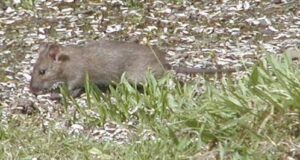
- Mice and other rodents eat wheat seeds, barley, maize, lentils, and chickpeas after planting, resulting in a low percentage of germination and a lack of production.
- attack the cotton crop from seed to seedling to plant. It also causes damage in the sugar cane fields and rice fields.
- cause significant damage to the tuber crops (potatoes, beets, onions, carrots, and ornamental bulbs) feeding on tubers and roots, causing sudden death of those plants.
- attack vegetable crops (melons) from seed to fruit, where they puncture and eat the content.
- attack fruit trees and feed on the bark of trees, causing the gradual, slow death of the young seedlings and fruit trees. Because they have a high ability to climb trees and twigs, they feed on the juiciness of the fruit (orange, lemon, apple) and even seed fruits (pistachios, walnuts).
- cause significant damage to the landscaping.
Damages to Public Utilities/ Facilities:
- Rodents damage and cause open gaps within doors, windows, and furniture, and destroy a large portion of which also ruptures and eats wallpaper and fabrics, clothes, books, and papers, and everything that marks the way in the kitchen of foodstuffs, fresh or cooked or stored.
- Rodents cause damage to public facilities (labs, hospitals, stores, grain silos, airports, ports of ships, and train stations) by consuming electrical cables and connecting wires, resulting in electric sparks that cause fires and damage to tools and electrical appliances.
- Rodents attack the body of the soily dam and build their nests, which, in addition to damaging the electric connections in the dam, cause severe damage to the dam.
Damages to Stored Materials
- The rodent consumes a fifth of its weight in grain per day, destroys twenty times more grain, and leaves the food materials contaminated with its urine, feces, and hairs.
- Norway rats weigh 400 g and consume 40 g per day, totaling 1600 g per day.It consumes about 30 The Norway rat consumes half as much as the roof rat, which weighs about 200 g.The house mouse and field mouse consume approximately 5 g of food per day, destroy 100 g, and consume an average of 2 g of grain.
Damages in the Field of Public Health:
- Rodent mammals live in filthy, polluted environments or waste collection sites.Many bacteria and pathogens that cause dangerous diseases in humans and domestic animals live on many rodent species.
- According to the reports of the World Health Organization (WHO), there are more than forty rodent-borne diseases.
| Mouse | Rat | Causing Agent | Disease Name |
| + | Leishmania spp | Leishmania | |
| + | Yersinia pestis | Plaque | |
| + | + | Salmonella spp | Salmonella |
| + | Shigella spp | Shigella | |
| + | + | Vibrio cholera | Cholera |
| + | + | Clostridium botulinum | Food Posoning |
| + | Rhabdo viruses | disease dog (Rypez) | |
| + | Hepatitis viruses | Hepatitis | |
| + | Hanta viruses | Haemorrhagic fever | |
| + | Trypanosoma cruzi | Disease Chaga’s |
The most important diseases that can be transmitted through rodents to humans.
Leishmania
- Leishmania is an animal that does not have chlorophyll and causes serious diseases in humans.
- The oval-shaped animal (3-5 microns) lives in the human body, rodents, and Leishmania parasites live in the body of the mosquito, the sandfly, Phlebotomus sp., and the infection passed on to the rodent when it absorbs blood from a patient’s body.
- There are two types of this pathogen: Leishmania skin and Leishmania entrails of the interior.
- The parasite is transmitted by sandflies, which absorb the blood through the piercing of diseased rodents carrying the parasite or from an infected person.
Plague
- The old laws are remembered as the most devastating and lethal epidemics that threatened rights for centuries, including the so-called black death.
- The roof rat (Rattus rattus) is a reservoir host of bubonic plague, with the oriental rat fleas that infest them being a prime vector of the disease.
- Theplague oftwotypes,namely:
- Bubonic plague (lymph nodes): the bacteria enter the bloodstream and travel to the liver, spleen, kidney, and brain, where they settle and cause one of the following pathological symptoms: high fever, body tremors, headache, vomiting, dizziness, and then tumors in the lymph nodes under the armpits and thighs.
- Pneumonic plague: the bacteria enter through the bloodstream and settle in the lungs. Delirium and extreme fatigue, insomnia, numbness, coma, memory loss, severe lung inflammation, and edema (fluid entrapment in the lungs) are all pathological symptoms.
Rat Bite Fever
- Definition: an infectious disease transmitted to humans by biting mice or
- Reasons: The pathogenic bacterium Streptobacillusis the causative agent of the disease.
- Synonyms: rat bite fever, mouse bite fever, Sudoku, Alsodjelkothe
- The spread of infection: The disease is transmitted to humans when exposed to the urine or oral secretions of other rodents, such as And this is usually due to a bite or even exposure to secretions.
- Complications:oneofthemostimportantreactionsofthediseaseispoverty inthe
- Treatment: Given penicillin as an effective treatment using 200–300 thousand IU (3–4 times per day for 6–7 days), tetracycline can be used for 7–14 days.
- Prevention and disease control measures
- avoidexposuretorodents andtheirlocations.
- the use of antibiotics when exposed.
- the use of toxic pesticides to eliminate them.
Murine Typhus
Rickettsia is the disease vector, and it is spread to humans by fleas, spiders, and mites. When a flea bites a human, the skin itches, and pathogens from the flea feces are released into the human body, causing the illness.
Salmonella
- The causing agent is a pathogen-shaped bacterium, Salmonella.
- The bacteria infects rodents and can be transmitted to humans or domestic animals (poultry and their products through food contaminated with rodent feces and urine).
- The symptoms are vomiting, high temperatures, abdominal pain, severe diarrhea, headaches, and chills.
Trichinosis ) Helical filaments disease)
- PathogenwormspiralnoodlesTrichinaspiralis
- Transmittedto humansfromporkorlunchfromcontaminatedrodentfecesandurine.
- The most important signs of the disease are diarrhea, abdominal pain, brain inflammation, and muscle pain when chewing.

